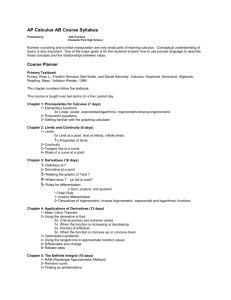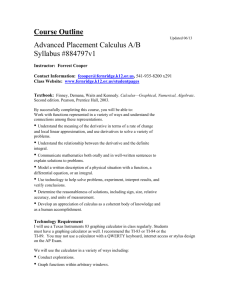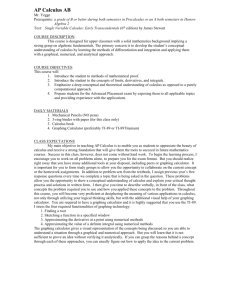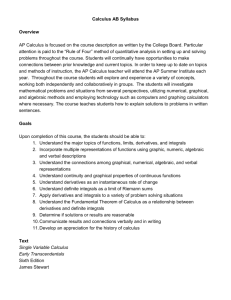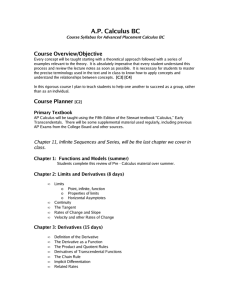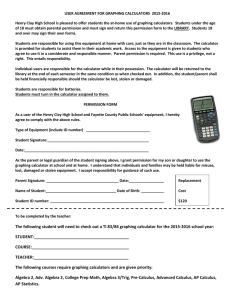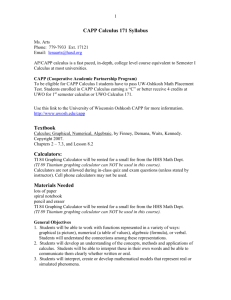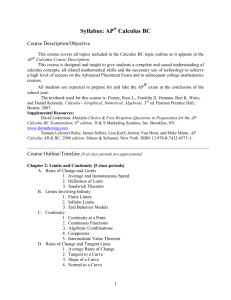AP Calculus Syllabus
advertisement
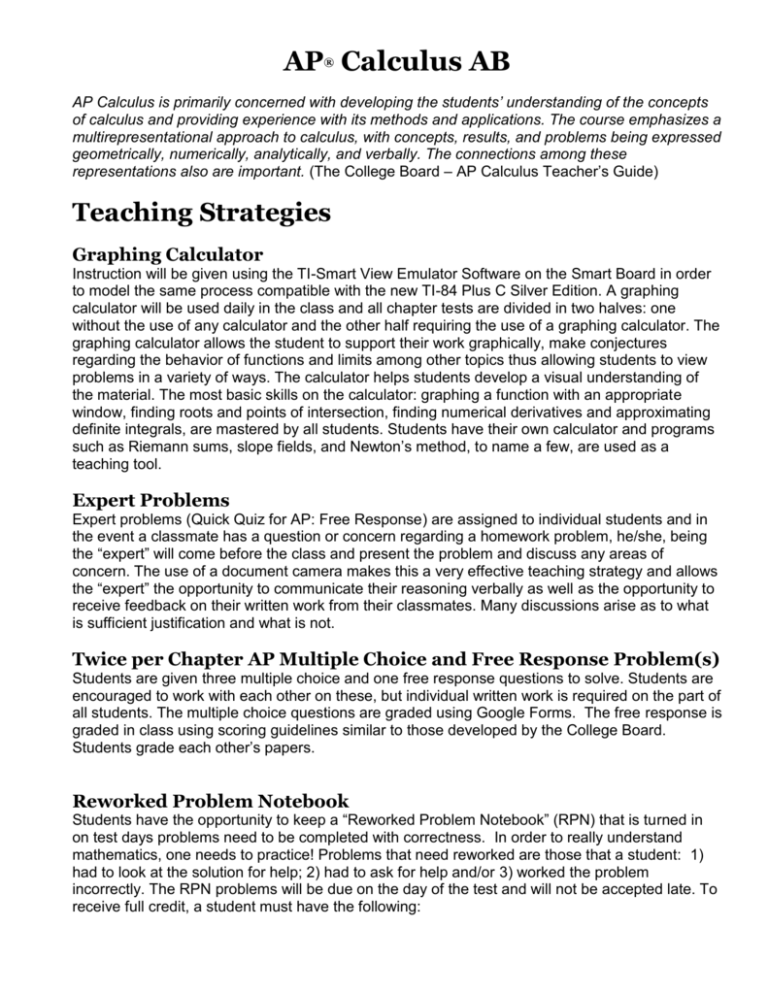
AP Calculus AB ® AP Calculus is primarily concerned with developing the students’ understanding of the concepts of calculus and providing experience with its methods and applications. The course emphasizes a multirepresentational approach to calculus, with concepts, results, and problems being expressed geometrically, numerically, analytically, and verbally. The connections among these representations also are important. (The College Board – AP Calculus Teacher’s Guide) Teaching Strategies Graphing Calculator Instruction will be given using the TI-Smart View Emulator Software on the Smart Board in order to model the same process compatible with the new TI-84 Plus C Silver Edition. A graphing calculator will be used daily in the class and all chapter tests are divided in two halves: one without the use of any calculator and the other half requiring the use of a graphing calculator. The graphing calculator allows the student to support their work graphically, make conjectures regarding the behavior of functions and limits among other topics thus allowing students to view problems in a variety of ways. The calculator helps students develop a visual understanding of the material. The most basic skills on the calculator: graphing a function with an appropriate window, finding roots and points of intersection, finding numerical derivatives and approximating definite integrals, are mastered by all students. Students have their own calculator and programs such as Riemann sums, slope fields, and Newton’s method, to name a few, are used as a teaching tool. Expert Problems Expert problems (Quick Quiz for AP: Free Response) are assigned to individual students and in the event a classmate has a question or concern regarding a homework problem, he/she, being the “expert” will come before the class and present the problem and discuss any areas of concern. The use of a document camera makes this a very effective teaching strategy and allows the “expert” the opportunity to communicate their reasoning verbally as well as the opportunity to receive feedback on their written work from their classmates. Many discussions arise as to what is sufficient justification and what is not. Twice per Chapter AP Multiple Choice and Free Response Problem(s) Students are given three multiple choice and one free response questions to solve. Students are encouraged to work with each other on these, but individual written work is required on the part of all students. The multiple choice questions are graded using Google Forms. The free response is graded in class using scoring guidelines similar to those developed by the College Board. Students grade each other’s papers. Reworked Problem Notebook Students have the opportunity to keep a “Reworked Problem Notebook” (RPN) that is turned in on test days problems need to be completed with correctness. In order to really understand mathematics, one needs to practice! Problems that need reworked are those that a student: 1) had to look at the solution for help; 2) had to ask for help and/or 3) worked the problem incorrectly. The RPN problems will be due on the day of the test and will not be accepted late. To receive full credit, a student must have the following: Reworked problems that are clearly labeled by chapter, section and number, neatly organized and worked thoroughly and correctly. Commentary of what was learned, what to watch for in the future and what needs to be studied, etc… The commentary is not necessary on every problem, but must be included occasionally to receive full credit. Tests Chapter tests are divided into two parts: 1) no calculator, and 2) graphing calculator, required. Chapter tests are given over a two day period. The second day will include a true or false and multiple choice test as a review of the previous chapter administered through Google Forms. AP Calculus AB Course Outline Primary eBook The eBook used for this course is: Finney, Ross L., Franklin D. Demana, Bert K. Waits, and Daniel Kennedy. Calculus—Graphical, Numerical, Algebraic. 4th ed. Menlo Park: Scott-Foresman Addison-Wesley, 2012. Other Resources AP Calculus Course Description AP Released Exams Microsoft Surface RT # Days Chapter 1: Prerequisites for Calculus – 11 days (1-1) Lines (1-2) Functions and Graphs (1-3) Exponential Functions (1-5) Functions and Logarithms (1-6) Trigonometric Functions 1 3 2 1 2 Chapter 2: Limits and Continuity – 10 days (2-1) Rates of Change and Limits (2-2) Limits Involving Infinity (2-3) Continuity (2-4) Rates of Change and Tangent Lines 2 3 2 2 Chapter 3: Derivatives – 11 days (3-1) Derivative of a Function (3-2) Differentiability (3-3) Rules of Differentiation (3-4) Velocity and Other Rates of Change (3-5) Derivatives of Trigonometric Functions 1 1 3 3 2 Chapter 4: More Derivatives - 11 days (4-1) Chain Rule (4-2) Implicit Differentiation 3 2 (4-3) Derivatives of Inverse Trigonometric Functions (4-4) Derivatives of Exponential and Logarithmic Functions 2 2 Chapter 5: Applications of Derivatives – 24 days (5-1) Extreme Values of Functions (5-2) Mean Value Theorem (5-3) Connecting f’ and f” with the Graph of f (5-4) Modeling and Optimization (5-5) Linearization and Differentials (5-6) Related Rates 5 1 3 2 3 6 Chapter 6: The Definite Integral – 20 days (6-1) Estimating with Finite Sums (6-2) Definite Integrals (6-3) Definite Integrals and Antiderivatives (6-4) Fundamental Theorem of Calculus (6-5) Trapezoidal Rule 1 2 6 4 2 Chapter 7: Differential Equations and Mathematical Modeling – 12 days (7-1) Slope Fields and Euler’s Method (7-2) Antidifferentiation by Substitution (7-4) Exponential Growth and Decay (7-5) Logistic Growth 2 3 2 3 Chapter 8: Applications of Definite Integrals – 18 days (8-1) Integral as Net Change (8-2) Areas in the Plane (8-3) Volumes (8-4) Lengths of Curves (8-5) Applications from Science and Statistics 3 4 4 2 3 Review and Preparation for the AP Exam – Approximately 4 weeks Practice exams are given, scored and analyzed. Some are done in groups while others are completed individually. Additional calculus topics introduced after the AP Exam. Chapter 7 and 9: Integration by Parts and L’Hopital’s Rule – 4 day (7-3) Integration by Parts (9-2) L’Hopital’s Rule 2 1

